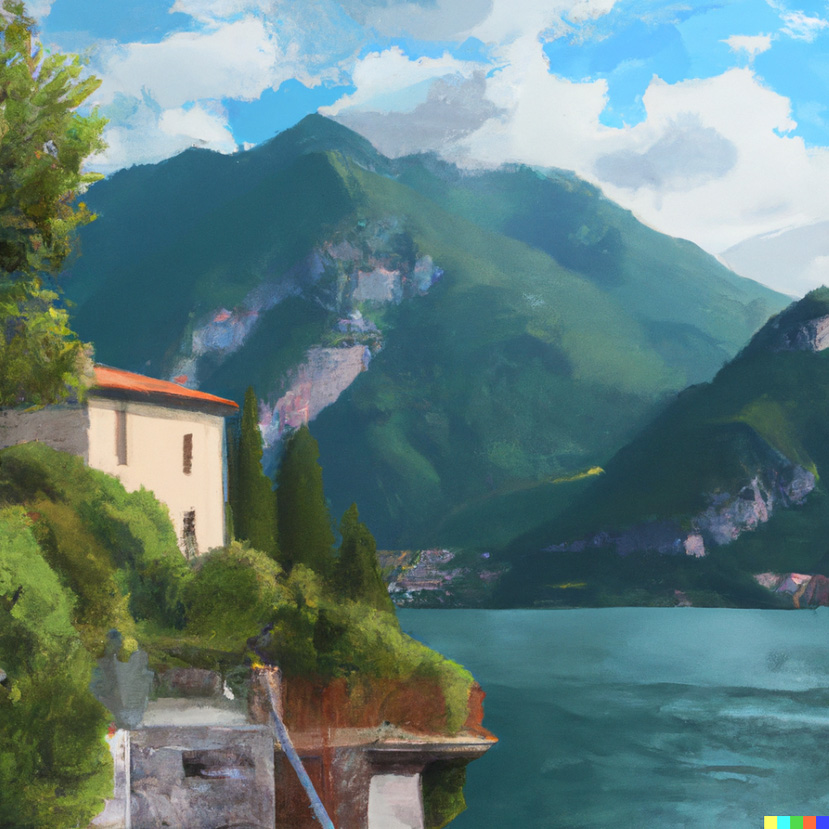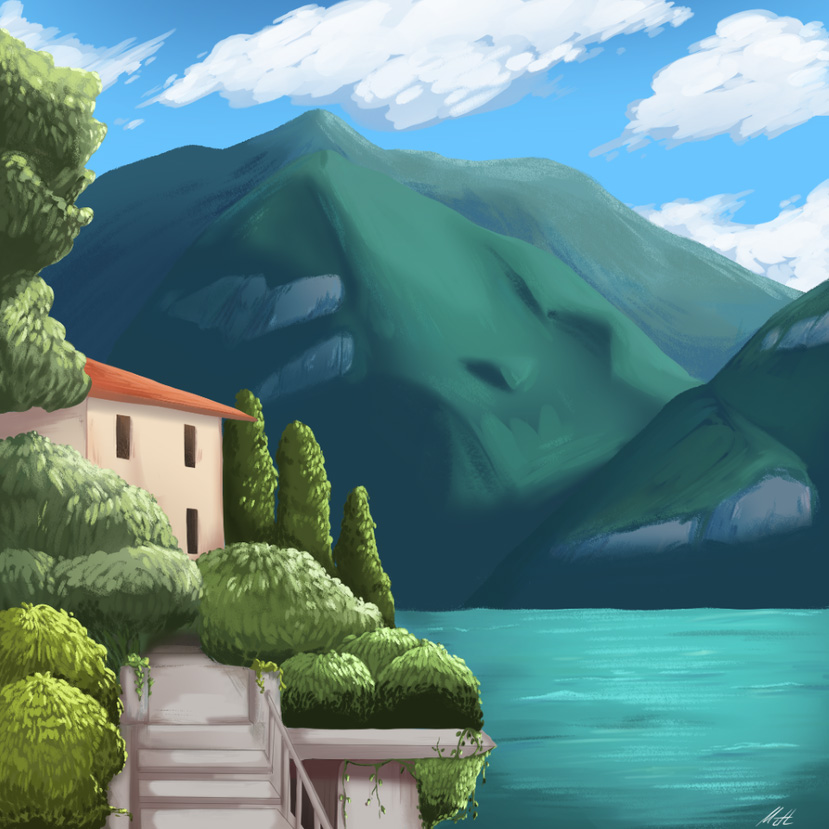Why AI Art could not thrive without Social Media
Marion Hoydal & Siri Angvik
The speed of production and surface level quality is a match made in heaven.
Everyone who engages with art and illustration on social media has seen the massive number of AI generated paintings that have come through our social media feeds over the last years, and especially these last months in 2022. Following close behind is rampant vocal protest from those who do not consider these AI creations ‘art’. This debate is not what I want to dissect, but rather the seemingly symbiotic relationship between AI art and social media. I believe that AI art would not, and could not, exist as we know it without platforms like Instagram, Facebook, and Twitter.
I think this relationship boils down to one single point; AI images do not hold up to scrutiny.

This is an AI generated image created in DALL-E 2 with the prompt ‘detailed painting of Italian countryside beautiful lake digital art’, created in just a few minutes. It looks incredible! It has an interesting composition and a pleasing colour palette. It seems reminiscent of impressionism, where planes of colour and clever use of shapes depict light and mood.
However, if we are to look closer and dissect the painting, the details that make up the painting don’t allude to anything akin to reality. Take a look at the house; the shape and colour palette resemble a picturesque Italian home, with light cream coloured walls and a bright orange roof. However, the windows stretch and bend in bizarre ways and almost melt into the bushes below. Further down the painting, we see some gray structure that could allude to a walkway—perhaps stairs—but upon looking closer it resembels nothing. What may be a metal pole in the very bottom left corner seems to support an invisible set of stairs. What we may call a red fence, right beside the pole, melts and bends beside the bushes, and bleeds over the gray structure. Is it really a fence? A wall or some roots sticking from the ground? Who knows.
A light turquoise ocean separates the house and the mountains. Nevertheless, it neither feels like or resembles a real ocean with its flat color, simple shape, and almost silk like texture. There is no alluding to a deeper ocean with either waves or different color variations. Resulting in ‘an ocean’ that does not feel calm, but lifeless. Combining all these different points together, you have an AI-generated painting that lacks a big aspect of visual art, intent. The intention of putting in detail and the effect it brings. The small detail that can make all the difference between a bush or a lump of green mass.
This then begs the question, why does this matter specifically on social media? answer is: it doesn't! AI images do not need to hold up to scrutiny on platforms like Instagram, because we do not scrutinise while on that kind of media. According to Facebook's internal analytics, people only spend 1.7 seconds on average on one piece of content while on mobile phones (Facebook IQ, 2016). On desktop the number is slightly higher with 2.5 seconds on average. I think many of us can relate to absentmindedly scrolling through Instagram, not spending even a second on each picture, and just indicating like for everything that inspires the slightest of positive emotions. This is the prime hunting ground for AI art. It does not need to make sense on deeper inspection, or hold your attention for long.
It just needs to appear pleasing to the eye for a couple of seconds, before we all inevitably move on to the next piece of content in the feed. This is not to mention how, on social media, quantity trumps quality. Posting often and consistently is one of the most common pieces of advice given on how to grow a social media presence. Everything about the structure of social media seems engineered to allow AI art to flourish. AI being able to generate a piece of content in minutes, compared to the hours it would take a person to create a similar image either by hand or in such as Photoshop. The relationship between AI and social media becomes symbiotic in a way. AI images profit from users’ lack of attention and critical faculties, and social media companies profit from AI images’ speed of production and consistency of content.
I think this is what in many ways will shackle AI art to social media. The other arenas where we engage with the visual arts: the gallery, as illustrations in books, in comics, decorating the walls of our homes, are defined by another factor: our sustained attention. I’ve stood for minutes in front of paintings in galleries, picking apart their details. Trying to understand how a single stroke of paint manages to convey light and depth. I’ve looked at pictures on the walls of my home over the span of almost twenty years, noticing something new time and time again. I’ve gotten lost in the illustrations of my childhood books, staring long into the worlds detailed on the page.
I think the reason I can do that is the clear intent behind every decision by the artist. By getting to know a piece of art, you in many ways get to know its creator. You see what they considered important, as well as seeing their mistakes creeping through. AI art does not carry this intentionality and character. It can be beautiful and impressive to behold, but I cannot get lost in it. Do people want these images hanging in their houses? Do people study them in galleries? Do we get lost in them on the pages of our favorite books? No. We dedicate a couple seconds of our time to looking at them in our Instagram feed, and then we forget them.
AI art, as we now know it, is dependent on social media because it cannot sustain our attention in the same way art made by humans can. While it may look pleasing to the eye for a moment, the lack of intent hinders it from ever being truly worthy of our prolonged attention. Even though the AI images may look related to impressionist paintings, the same unclear lines and use of colours, each stroke in an impressionist painting builds the scene and adds effect, emotion and depth. Whereas an AI generated painting cannot copy intent and the honesty that lies with every artist and is visible in both their strokes and mistakes. AI will probably replace us as ‘content creators’, but i do not believe it will replace us as designers, creatives, or artists.

Refrences:
-
Facebook IQ 2016. Capturing Attention in Feed: The Science Behind Effective Video Creative. Available at:
https://www.facebook.com/
business/news/insights/ (Accessed: 21 November 2022)capturing-attention-feed-video-creative
